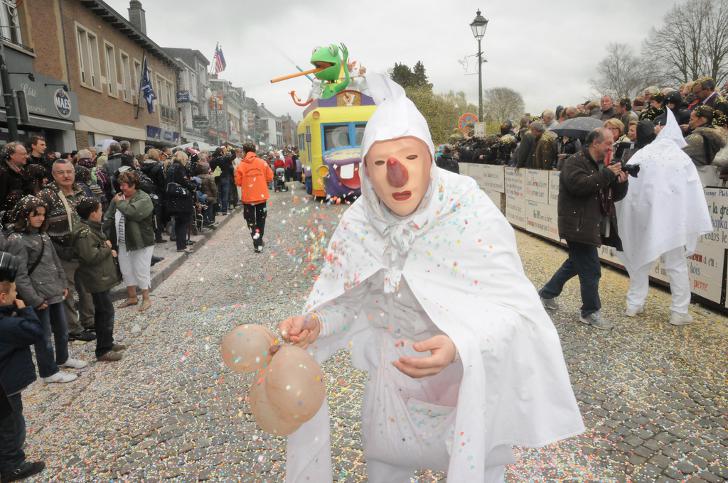For many centuries Stavelot was the capital of the Principality of Stavelot-Malmedy where princely power was exercised by a Benedictine abbot (Prince-Abbot). He prohibited the clergy from joining popular celebrations. The locals missed the jovial presence of the monks so they decided to renounce and mock the prohibition. Revelers dressed up as clergy, donning robes and hoods similar to monks’ clothing.
When the reigning Prince-Abbot prohibited wearing clothes that were too similar to clergy attire, the citizens of Stavelo-Malmedy came up with a new costume consisting of a white hooded robe and a white mask with a long red nose. This costume was authorized by the Prince-Abbot. That’s how characters known as the Blancs-Moussis (White Moussis) were born in 1502.
The Blancs-Moussis have become iconic figures in Walloon folklore and an emblematic group of the Stavelot Carnival. The annual festivities dwindled during the first half of the 20th century, largely to World Wars I and II, but the Carnival was revived in 1947 by a group of enthusiasts and has since become a major tourist attraction and one of the most anticipated events in the region.
Today’s Carnival of Stavelot is a three-day celebration featuring around 200 Blanc-Moussis in their traditional costumes, several dozen folk groups and music companies from all over Wallonia, and guests of honor.
The Carnival kicks off on Saturday night with a nighttime procession and the traditional ball at the Abbey. The highlight of Laetare de Stavelot is the Grand Parade held on Monday afternoon. It features the Blanc-Moussis who throw confetti, dance, entertain the spectators and hit them with dried pig bladders. The White Moussis are followed by other folk groups. The day concludes with a fireworks display and the White Night (Nuit Blanche) in the cellars of the Abbey. Monday is the day of concerts by music and folk groups.
The Carnival of Stavelot attracts around 35,000 visitors. During the year, the Blanc-Moussis attend other carnivals in Belgium and abroad, acting as cultural ambassadors representing Walloon culture.

Photo: U.S. Ambassador Gutman




